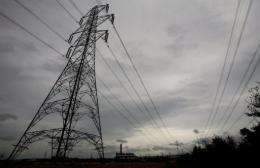British electricity pylons to get a makeover

Electricity pylons across the British countryside may soon cease to be eyesores thanks to a government backed competition for a new design.
Pylons are universally regarded as blots on the landscape and their shape has barely changed since the 1920s.
Now officials say many more are likely to be needed in the next ten years as new electricity capacity, such as from wind farms, comes on stream to meet increasing demand.
The Royal Institute of British Architects (Riba), which is running the contest for the Department of Energy and Climate Change and National Grid, is inviting architects, designers and engineers to come up with ideas for a makeover of the unloved but essential structures.
There are currently 88,000 electricity pylons in the UK, including 22,000 on National Grid's main transmission network in England and Wales. The 50-metre high steel lattice towers in the transmission network carry electricity for thousands of miles around the country.
Their design, chosen by leading architect Sir Reginald Blomfield in 1927, and barely changed since, makes them resistant to high winds and lightning strikes and able to cope with the load and tension of the cables.
But the sight of them in the countryside, particularly in more beautiful and remote spots, can spark controversy.
Energy and Climate Change Secretary Chris Huhne said: "The dual challenge of climate change and energy security puts us on the brink of a new energy construction age.
"The equivalent of 20 new power stations is needed by 2020, much more beyond that, and they'll need connecting to the grid. It's crucial that we seek the most acceptable ways of accommodating infrastructure in our natural and urban landscapes."
The Department of Energy said a quarter of the UK's existing electricity generating capacity, old nuclear reactors and coal-fired power stations, will close by 2020.
By the end of the decade, officials suggest that 30 percent of electricity supplies will come from renewables such as wind and wave power, as the UK attempts to cut carbon from electricity generation.
National Grid's executive director UK, Nick Winser, said: "Much of the new low-carbon generation is planned for remote or coastal areas, which means new infrastructure will be needed to get the electricity we need to our homes, businesses and vehicles.
"The pylon as we know it has served the nation well, but new technologies and materials mean there may now be opportunities for new designs."
Friends of the Earth's director of policy and campaigns, Craig Bennett, said: "We need to radically overhaul the way we generate and use electricity over the next twenty years to tackle climate change -- so updating the design of the pylons which carry it couldn't be more timely.
"Developing green energy sources like offshore windfarms will generate tens of thousands of new jobs -- but we'll also need huge investment in the National Grid to connect remote turbines to the places where energy is used.
"Power cables should be buried underground to mimimise the impact on the most environmentally sensitive areas -- but some new overhead pylons will inevitably be needed."
The competition closes on July 12, and shortlisted entrants will be given the chance to work with National Grid before final designs -- which will be available for the public to view -- are submitted in September and judges make a decision on the winner in October. The competition winners will share a prize fund of £10,000.
(c) 2011 AFP



















